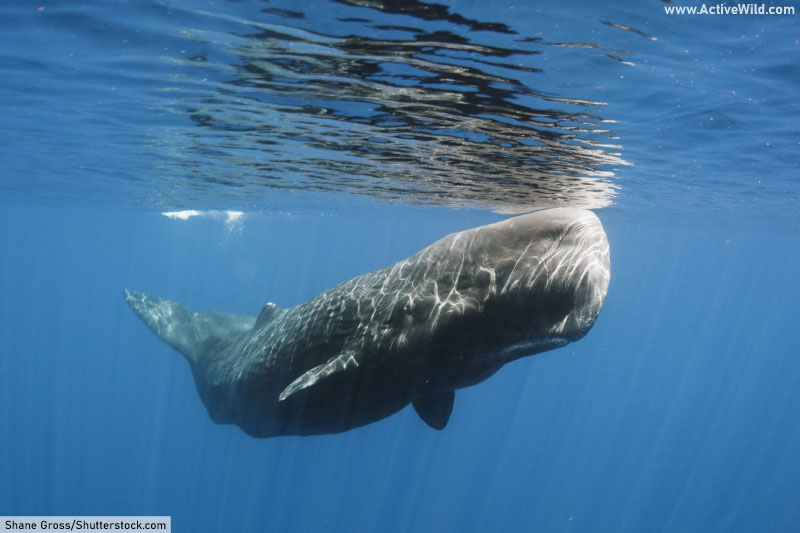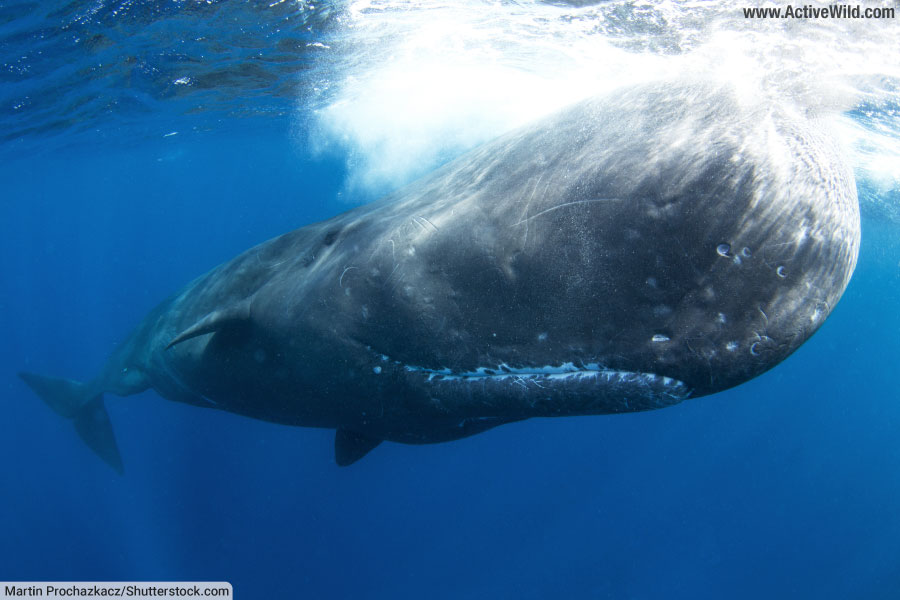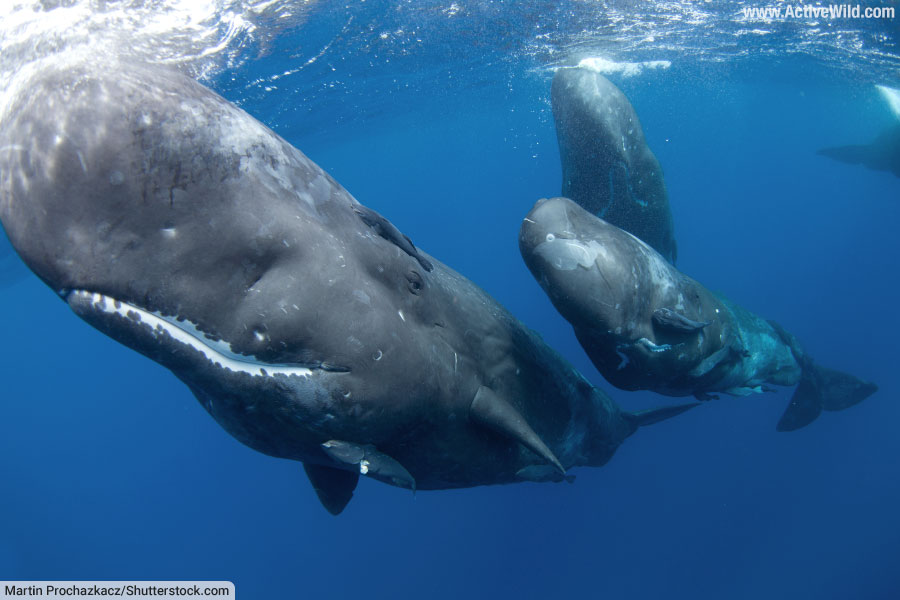The sperm whale is the world’s largest toothed predator, and one of the deepest-diving, hunting giant squid at depths of over 2 km / 1.24 miles below the surface.
Moby Dick, the fearsome “white whale” in Herman Melville’s book of the same name, was based on a sperm whale. Melville’s story was partly based on a real incident in which a whaling ship was sunk after having been attacked by a sperm whale.
On this page you’ll find a complete guide to this formidable marine mammal…
Page Index
- Top Sperm Whale Facts
- What Is A Sperm Whale?
- Sperm Whale Statistics
- What Does A Sperm Whale Look Like?
- Sperm Whale Family & Related Species
- Where Are Sperm Whales Found?
- Sperm Whale Diet & Hunting
- Sperm Whale Life Cycle
- Are Sperm Whales Endangered?
- Sperm Whale Predators
- Moby Dick
- Discover More With Active Wild
Discover every living species of whale on this page: Types of Whales

Top Sperm Whale Facts
- The sperm whale is the largest toothed whale, and the world’s largest living toothed predator.
- The sperm whale has the largest brain of any animal. A sperm whale’s brain weighs around 7.8 kilograms (17 lb) on average.
- The clicks produced by a sperm whale can reach a volume of 230 decibels, and are the loudest-known sounds produced by an animal.
- The sperm whale is the 3rd deepest diving mammal; only the southern elephant seal and Cuvier’s beaked whale are known to dive deeper.
- Sperm whales can live for 70 years or more
- Moby Dick, the fearsome “white whale” in Herman Melville’s book of the same name, was based on a sperm whale
- The sperm whale is not only the largest toothed whale, but also the world’s largest toothed predator.
- Ambergris is a rare and valuable substance produced in the digestive system of sperm whales. Once aged, is used in perfumery for its unique ability to fix scent to human skin. The sharp beaks of consumed squid are thought to instigate the production of ambergris.
- It is estimated that the world's sperm whale population consumes only slightly less seafood each year than the total global human population.
- The sperm whale is among the most sexually dimorphic of all cetaceans, with males being significantly longer, and over twice the weight, of females. (Sexual dimorphism is the difference in physical characteristics between males and females.)
What Is A Sperm Whale?

The sperm whale, Physeter macrocephalus, is marine mammal belonging to the group Cetacea, which is home to all whales, dolphins and porpoises.
Sperm whales are easily recognizable by their massive heads, which can make up to one-third of their total body length, and their distinctive box-like shape. They are named for the waxy substance called spermaceti found in their large heads, once mistaken for sperm by early whalers (hence the whale’s common name).
Distributed throughout the world's oceans, sperm whales prefer deep waters in which they can dive to depths of over 2,000 meters (1.24 miles) in search of food, primarily giant squid. They are among the deepest diving of all mammals.
Sperm whales have a complex social structure, with females and juveniles living in groups while mature males tend to be solitary or move from group to group.
The species is known for its unique vocalizations, or "clicks," which it uses for echolocation and communication.
The sperm whale was once heavily hunted for its blubber and spermaceti. Overhunting caused the species’ population to fall to around a third of its original size. Despite now being protected, the slow-breeding species is struggling to increase its population.
Toothed Whales
The sperm whale is a toothed whale. Toothed whales belong to the suborder Odontoceti, one of the two main groups of whales (the other being the baleen whales of parvorder Mysticeti).
Toothed whales are distinguished from baleen whales by having teeth instead of baleen plates, a single blowhole (instead of two blowholes), and a more developed sense of echolocation.
Examples of toothed whales include dolphins (including the killer whale), beaked whales, and sperm whales.
Sperm Whale Statistics
- Scientific Name: Physeter macrocephalus
- Order: Cetartiodactyla
- Family: Physeteridae
- Length: up to 18 meters (60 feet)
- Weight: Up to 45,000 kilograms (99,208 pounds)
- Where Found: Deep ocean waters worldwide
- Conservation Status: Vulnerable
What Does A Sperm Whale Look Like?

One of the most distinctive large whales, the sperm whale has a box-like shape with a blunt, squarish forehead and a narrow lower jaw. The whale’s enormous head constitutes about one-third of its total body length.
The whale’s skin is dark grey or brownish, with lighter-colored undersides. A single blowhole is located on the left of the top of the head, causing the whale’s spout to be angled forward and to the left.
The sperm whale’s flippers are short and wide and located slightly behind the head, while the flukes (tail fins) are broad and triangular, with a deep notch in the middle.
There is a series of ridges along the whale’s back, leading to a small, triangular dorsal fin towards the tail.
The whale’s teeth, found only on the lower jaw, can be quite large (up to 20 centimeters in length and 1 kg / 2.2 lb in weight) and fit into corresponding sockets in the upper jaw when the whale’s narrow mouth is closed.
Although they look small relative to size of its body, the sperm whale’s eyes are among the largest of all mammals, measuring 7×7×3 cm and weighing around 170 g.
Related Species

The sperm whale is the only living member of its family, Physeteridae. The whale is part of a larger superfamily, Physeteroidea, which also includes the dwarf sperm whale (Kogia sima) and the pygmy sperm whale (Kogia breviceps), both of which belong to the family Kogiidae.
Although significantly smaller than the sperm whale (both are around the size of a large dolphin), the dwarf sperm whale and pygmy sperm whale share several traits with their larger cousin, including a spermaceti organ in their heads and a predilection for deep-water squid.
While these are the closest living relatives to the sperm whale, numerous extinct relatives, known from fossils, also belonged to these families and to other families within Physeteroidea.
Where Are Sperm Whales Found?
Sperm whales are found throughout the world's oceans, making them one of the most widely distributed mammals on the planet. They are a pelagic species, which means they tend to inhabit the open ocean rather than areas near the coast.
Sperm whales are usually found in waters that are over 1,000 meters deep, although they are known to occasionally venture into shallower waters. They inhabit both tropical and cool waters, including the Atlantic, Pacific, and Indian Oceans, as well as the Mediterranean and Caribbean Seas.
Typically, only adult males are found in higher latitude, colder waters, while females and young males tend to remain in tropical and subtropical regions. Males embark on long-distance migrations between these areas, especially during the breeding season.
The highly migratory nature of sperm whales, combined with their deep-diving habits, make them somewhat elusive and challenging to study, which means there is still much to learn about their global distribution and migratory patterns.
Sperm Whale Diet & Hunting
The sperm whale’s diet primarily consists of cephalopods, with a strong preference for squid – in particular, the giant squid and colossal squid – but it also eats octopuses and fish, including rays and sharks.
A sperm whale can consume about 3% of its body weight per day, which equates to around a ton of food for an adult male.
Diving
The sperm whale dives to great depths when hunting, and has been recorded at depths of up to 2,250 meters (7,382 ft / 1.4 miles). It is the third-deepest diving mammal, after the southern elephant seal and Cuvier’s beaked whale.
The whale’s dives can last for around an hour, but usually last closer to 35-45 minutes, followed by a period of recovery at the surface.
Echolocation
The sperm whale uses a highly developed form of echolocation to locate its prey. It produces a series of clicks that bounce off its prey, and by interpreting the returning echoes, the whale creates a mental image of its target.
The whale’s clicks are the loudest sound produced by any animal, measuring up to 230 decibels, which is louder than a jet plane taking off.
Using echolocation allows the whale to hunt in the pitch-black environments of the deep ocean where sunlight doesn't penetrate.
Once prey has been located the whale moves in rapidly and captures its victim using its strong jaws and sharp teeth.
Sperm Whale Life Cycle

A female sperm whales give birth to a single calf approximately every 4 to 20 years, after a gestation period that lasts about 14 to 16 months.
A newborn calf can measure up to 13 feet (4 meters) in length.
Sperm whales have one of the longest periods of parental care in the animal kingdom. Infants are nursed for several years – in some cases, over a decade.
As the young whales grow, they stay within a social group comprised of females and juveniles. Males typically leave these "nursery schools" between the ages of 4 and 21 years to join "bachelor schools" of other similarly aged males or live solitarily. During this time, they continue to grow and mature, with males growing significantly larger than females.
Sperm whales are not considered sexually mature until they are about 10 years old for females and at least 18 years old for males. However, it's common for males not to successfully reproduce until they are well into their twenties or thirties, as larger, older males tend to be more successful in mating.
Females typically stop reproducing by about age 40 but can live for several more decades. Males can continue to reproduce into old age.
The lifespan of a sperm whale is impressive, with females living up to 70 years and males living about 50 years, although there are records of some individuals surpassing these ages.
Are Sperm Whales Endangered?
Although not currently endangered, the sperm whale is a threatened species, and is listed as "Vulnerable" on the IUCN’s Red List.
Threats to sperm whales include entanglement in fishing gear, ship strikes, ocean noise, pollution, and historically, commercial whaling. Despite the ban on commercial whaling by the International Whaling Commission in 1986, sperm whale populations are still recovering, due to their exceptionally long life cycle.
Sperm Whale Predators

A mature sperm whale is a large and formidable opponent and has no natural predators. Sperm whale calves and sick adults are occasionally targeted by pods of killer whales.
Moby Dick
"Moby Dick," the renowned novel by Herman Melville, was inspired both by the story of a real-life sperm whale known as Mocha Dick and the infamous maritime tragedy of the whaleship Essex.
Mocha Dick was a notorious albino sperm whale known for its formidable size and tenacity, frequently battling whaling ships in the early 19th century near the island of Mocha, off the coast of Chile.
The Essex was a Nantucket whaling ship that was sunk by a large sperm whale in the Pacific Ocean in 1820. The survivors endured a harrowing ordeal at sea that became a well-known tale of survival.
Melville was influenced by both of these events, fusing them into his fictional narrative where the white whale, Moby Dick, embodied the untamed and indestructible force of nature, perpetually pursued by the obsessive Captain Ahab.
Discover More With Active Wild - Further Reading
Visit our main animals page: Animals
You can see pictures and facts on EVERY species of dolphin on this page: Types of Dolphins
You can see more ocean animals on this page: Ocean Animals List with Pictures & Facts
You can find out more about mammals on this page: Mammals – The Ultimate Guide
Discover different types of mammals on this page: Types of Mammals

